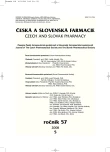Impact of demographic factors on consumption of pharmaceuticals in the Czech Republic
Authors:
L. Práznovcová
Authors place of work:
Univerzita Karlova v Praze, Farmaceutická fakulta Hradec Králové, Katedra klinické a sociální farmacie
Published in the journal:
Čes. slov. Farm., 2008; 57, 225-228
Category:
Původní práce
Summary
The present analytical study examines the dynamic increase in the consumption of pharmaceuticals in the years 1995–2005. In this period, the average annual increase in expenses for pharmaceuticals was 367 crowns per 1 inhabitant, the rate of expenditure being more dynamic in comparison with total health expenditures. The increase resulted from the increase in the average price of one packet. The analysis revealed statistically significant differences between individual age group. The consumption of pharmaceuticals in financial representation in the age group over 60 years is more than 8 times higher in comparison with the consumption in the age group younger than 20 years. The situation is similar in the other segments of health care (outpatient care, inpatient care). In 2005, the expenses from private resources of the households of pensioners were by more than 80% higher in comparison with other social groups. The rules of drug policy and the determination of prices of pharmaceuticals reimbursed from public resources should take account of the social consequences resulting from individual regulatory measures for individual groups of the population, in particular for the group of the population of the post-productive age.
Key words:
pharmaceutical expenditures – prognosis – age group – private resources
Zdroje
1. Annual growth in drug expenditure and in total health expenditure, 1998 to 2003. OECD Health Data 2005, June 05.
2. Mossalios, E., Mrazek, E., Walley, T. (ed.): Regulation pharmaceuticals in Europe: Striving for efficiency, equity and quality. Berkshire, England Open University Press, 2004.
3. Kanavos, P.: European pharmaceutical policy and implication for current member states and candidates countries. In Health policy and European Union enlargement (ed. McKee, M., McLehose, L., Nolte, E.) Berkshire, England Open University Press, 2004, 240–264.
4. Analýza zdravotnických účtů ČR. Český statistický úřad 2005.
5. OECD Health Data 2004, June 05. A Comparative analysis of 30 Countries. CD ROM. Ekonomické informace ve zdravotnictví 2005–2006. Praha, ÚZIS ČR, 2006.
6. Zdravotnictví jako součást národní ekonomiky 2005–2006. Praha, ÚZIS ČR, 2008.
7. Práznovcová, L., Strnad, L.: Zdraví, zdravotnictví a léková politika v ČR a v zemích EU. Praha, Maxdorf, 2005.
8. Freemantle, N., Bloor, K.: Lessons from international experience in controlling pharmaceutical expenditure.I.: influecing patients. BMJ, 1996, 312; 1469–1471.
Štítky
Farmacie FarmakologieČlánek vyšel v časopise
Česká a slovenská farmacie

2008 Číslo 5
- Přerušovaný půst může mít významná zdravotní rizika
- Ukažte mi, jak kašlete, a já vám řeknu, co vám je
- Mikroplasty a jejich riziko pro zdraví: Co všechno víme?
Nejčtenější v tomto čísle
- Historie a současnost hypolipidemické terapie
- Vliv montelukastu na léčbu astma bronchiale u dětských pacientů s celoroční alergickou rýmou
- Léčivé přípravky v pražských lékárnách koncem 16. století
- Vliv demografických faktorů na spotřebu léčiv v České republice
